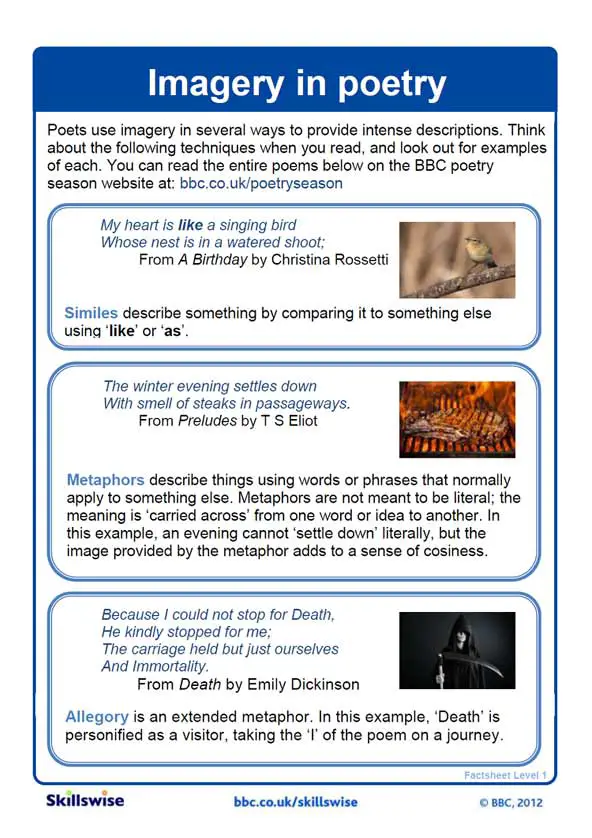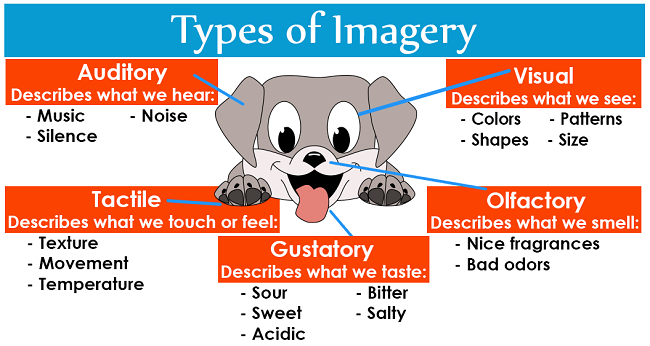

- 5 TYPES OF IMAGERY IN POETRY HOW TO
- 5 TYPES OF IMAGERY IN POETRY FULL
Understanding literary elements is necessary for literary analysis. By the end of grade 10, read and comprehend literature, including stories, dramas, and poems, at the high end of the grades 9-10 text complexity band independently and proficiently. RL.9-10.10 By the end of grade 9, read and comprehend literature, including stories, dramas, and poems, in the grades 9-10 text complexity band proficiently, with scaffolding as needed at the high end of the range.RL.9-10.4 Determine the meaning of words and phrases as they are used in the text, including figurative and connotative meanings analyze the cumulative impact of specific word choices on meaning and tone (e.g., how the language evokes a sense of time and place how it sets a formal or informal tone).RL.9-10.2 Determine a theme or central idea of a text and analyze in detail its development over the course of the text, including how it emerges and is shaped and refined by specific details provide an objective summary of the text.RL.9-10.1 Cite strong and thorough textual evidence to support analysis of what the text says explicitly as well as inferences drawn from the text.Kids need student-friendly worded objectives. This is for your administrator, not your kids. Teaching imagery in poems may cover the following ELA Common Core Standards. “In a Station of the Metro” by Ezra Poundįor examples of short stories for teaching imagery, follow the link.“The Red Wheelbarrow” by William Carlos Williams.Anything by Keats, Shelley, Byron, Blake, or Wordsworth.
 “Stopping by Woods on a Snowy Evening” by Robert Frost. The following list of poems will help you as you teach imagery in poetry: “Eulogy for a Hermit Crab” by Pattiann Rogers– Rogers description of a hermit crab conveys her love of nature and the majesticness of all god’s creatures. Discuss how Poe’s images contribute to the ominous setting of the narrative. “The Raven” by Edgar Allan Poe”– Poe’s classic serves as an example for just about every element of poetry. “Summer” makes a fun poem for young scholars to learn imagery. “Summer” by Walter Dean Myers – As you’ve probably guessed, “Summer” describes summer using images of “Bugs buzzin from cousin to cousin,” and “Juices dripping running and ripping” (3-5). She then connects the image of the sea to the image of God, equating motherhood to godliness. “Rocking” by Gabriela Mistral – Mistral uses images of the divine sea and connects them to the rocking of her son. Remind students that authors use imagery in poetry to create a specific feeling. I recommend reading this poem aloud and throwing something (like a thunderbolt) against the wall on the last line. The second stanza focuses on the majesticness of nature. The first stanza focuses on the harshness of nature. “The Eagle” by Alfred Lord Tennyson – This short poem takes 10 seconds to read and 45 minutes to analyze.
“Stopping by Woods on a Snowy Evening” by Robert Frost. The following list of poems will help you as you teach imagery in poetry: “Eulogy for a Hermit Crab” by Pattiann Rogers– Rogers description of a hermit crab conveys her love of nature and the majesticness of all god’s creatures. Discuss how Poe’s images contribute to the ominous setting of the narrative. “The Raven” by Edgar Allan Poe”– Poe’s classic serves as an example for just about every element of poetry. “Summer” makes a fun poem for young scholars to learn imagery. “Summer” by Walter Dean Myers – As you’ve probably guessed, “Summer” describes summer using images of “Bugs buzzin from cousin to cousin,” and “Juices dripping running and ripping” (3-5). She then connects the image of the sea to the image of God, equating motherhood to godliness. “Rocking” by Gabriela Mistral – Mistral uses images of the divine sea and connects them to the rocking of her son. Remind students that authors use imagery in poetry to create a specific feeling. I recommend reading this poem aloud and throwing something (like a thunderbolt) against the wall on the last line. The second stanza focuses on the majesticness of nature. The first stanza focuses on the harshness of nature. “The Eagle” by Alfred Lord Tennyson – This short poem takes 10 seconds to read and 45 minutes to analyze. 5 TYPES OF IMAGERY IN POETRY FULL
The first two stanzas are full of images the final two stanzas contains the poet’s reflections about the images. Wordsworth suggests that being one with nature equates to being one with the Universe or God.
“I Wandered Lonely as a Cloud” by William Wordsworth – Write this poem on the board, identify the images, and comment on how they contribute to the poem’s theme. The following examples of poetry using imagery will help. When teaching imagery in poetry, focus on its function. Using imagery: Being able to use imagery to convey more clearly a specific message equates to mastery. Interpreting imagery: Explaining why the author chooses a particular image and what effect it has on the poem’s theme puts one in the upper echelon of poetry analysts. Identifying imagery: Being able to identify imagery raises one above the level of primates, but it still falls short of mastery. Then I realized simply knowing a definition means nothing. No one else though I was cool except for my English teacher who gave me an ‘A’ on my literary terms matching quiz.  The definition of imagery: I thought I was pretty cool in high school because I knew that imagery was the use of vivid or figurative language to represent objects, actions, or ideas. Your lesson plans should incorporate the following: There are multiple levels of understanding imagery.
The definition of imagery: I thought I was pretty cool in high school because I knew that imagery was the use of vivid or figurative language to represent objects, actions, or ideas. Your lesson plans should incorporate the following: There are multiple levels of understanding imagery. 5 TYPES OF IMAGERY IN POETRY HOW TO
Teach students how to annotate and analyze a poem before focusing on one specific element. Just print, make copies, and accept accolades from colleagues and students. These units are teacher ready and student ready.

Imagine having 11 complete poetry units with handouts and lesson plans completed.








 0 kommentar(er)
0 kommentar(er)
